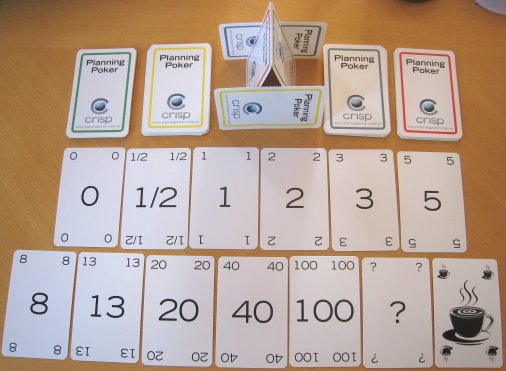Planning Poker®
Note: Crisp no longer sells planning poker decks.

Estimating is one of the supporting activities in Scrum and other agile processes. This means the process of assessing the size of a story, i.e. how long it will take, how much work it is to implement, how expensive it is, or however you want to put it. In Scrum, estimating is a team activity. For each story, the whole team participates in the estimation process. Planning Poker® (sometimes called Scrum poker) is a simple but powerful tool that makes team-estimating faster, more accurate, and more fun. The term was coined by James Grenning and popularized by Mike Cohn.
Estimating without Planning Poker
Here’s a typical problem with team estimates. Let’s say we are in a sprint planning meeting and the Product Owner says:

So the team starts thinking about how long the story will take (in ideal man-days in this case)….

Mr A believes that he knows exactly what needs to be done, so he thinks this will take 3 days. Mrs B and C are more pessimistic. Mr D and E are slacking off. So Mr A says ”3 days”.

This makes B and C confused. They start doubting their own estimates. Mr E wakes up and doesn’t really know what is being estimated. D is still dozing.The product owner asks for the rest of the team’s estimates.

As you can see, the rest of the team has been heavily influenced by A, just because A spoke up first. This is very risky! Both B and C thought it would take significantly longer than 3 days, their doubts should be aired!
Estimating with Planning Poker
Now imagine that each team member is holding a deck of cards, containing the following cards: ![]()
Let’s redo the estimation. The product owner says:

Once again, the team starts thinking about how long the story will take.

This time nobody blurts anything out. Instead they all have to present a card, face down, containing their estimate. Everybody has to present a card, so Mr D and E wake up. Mr D admits that he was sleeping and asks what the story is about. It’s harder to slack off when doing estimates this way :o) When they are done, all cards are turned over simultaneously, revealing everyone’s estimates.

Whoops! Big divergence here. The team, in particular Mr A and Mrs C, need to discuss this story and why their estimates are so wildly different. After some discussion, Mr A realizes that he has forgotten some important tasks that need to be included in the story. Mrs C realizes that, with the design that Mr A presented, the story might be smaller than 20. After the discussion (3 minutes in total) they do another estimation round for that same story. 
Convergence! OK, not complete convergence. But they agree that an estimate of 5 should be close enough. Next story.
Why the strange number series?
![]()
The higher numbers have less granularity. Why? Why is there no 21 for example? Several reasons:
- Speed up the estimation process by limiting the number of choices (i.e. number of cards).
- Avoid a false sense of accuracy for high estimates.
- Encourage the team to split large stories into smaller ones.
A high estimate (> 20 for example) usually means that the story is not well understood in detail. It would be a waste of time to discuss whether the story is 19, 20, or 22.5. It is simply a big story, and a 20 will reflect that. If you want to get into detail, break the story down into several smaller stories. Smaller stories can be estimated in greater detail.
Special cards
| The zero card means “this story is already done” or “this story is pretty much nothing, just a few minutes of work”. | |
| The question mark card means “I have absolutely no idea at all. None.” Should be rare. If this card is used too often, the team needs to discuss the stories more and try to achieve better knowledge spread within the team. | |
| The coffee cup card means “I’m too tired to think. Let’s take a short break.” |
Planning Poker® is a reg. trademark of Mountain Goat Software, LLC. Sequence of values is (C) Mountain Goat Software, LLC.